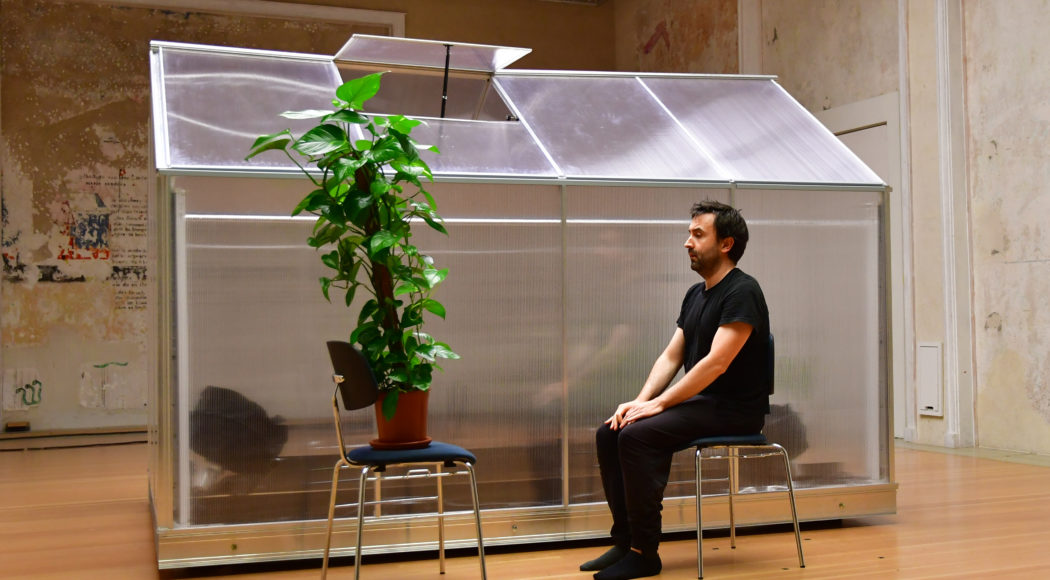To See Climate (Change), #1 – 2021
Romuald Krężel and René Alejandro Huari Mateus report on their Artist-in-Garden Residency at HELLERAU. To See Climate (Change) is an artistic research project that we initiated in early 2020 at Akademie Schloss Solitude in Stuttgart, developed in June 2020 at LAB Frankfurt and from August to September 2020 at the Artist-in-Garden Residency at HELLERAU. Starting from questions about ecological sustainability and environmental degradation, we have searched for different performative and choreographic strategies that allow us to make the invisible – the climate – and its changes speculatively visible. We have tried to build a landscape of images, affects and choreographic sequences, all based on the possible exchange between humans and “non-humans”.
List of residents/participantss/materials/entities involved in theResidency:
House
A greenhouse (6.5 m2). Assembly of polycarbonate panels with aluminum poles. Placed on an aluminum frame with 4 wheels so that it can move freely in the performance space.
- 16 aluminum rods
- 25 polycarbonate panels
- 112 screws
- 132 nuts
Plants
26 potted plants, bought in plant stores in Stuttgart and Dresden. During our stay, the plants lived in a room with sufficient access to sunlight. For the time of the samples, they were placed in the greenhouse in the Nancy-Spero room. Although the distant ancestors of the potted plants originally came from places near the equatorial line, the plants from our project were mostly born in huge greenhouses for reproduction purposes in the Netherlands and Germany.
- 1 yucca
- 1 Croton
- 1 Dieffenbachia reflector
- 2 Fittonias, also known as nerve plants (red and green)
- 1 Alocasia California, better known as Elephant Ear (with many spreading leaves that grow in all directions, so moving this plant requires a real virtuosity)
- 3 Dracaenas (Dracaena Fragrans and 2 Dracaenas Marginatas).
- 1 Homalomena Rubescens,called Maggy
- 1 Fern (withered)
- 3 Kalatheas (Orbifolia, Zebrina and Triostar)
- 1 Kentia palm
- 1 Areca palm
- 1 Dieffenbachia summer (withered)
- 1 Carex oshimensis “Everest
- 2 Spathiphyllum laurettas (with two white flowers looking at you as viewer:in)
- 1 Schefflera arboricola, also known as dwarf umbrella tree
- 3 Ficusse (1 Exotica and 2 Anastasias)
- 1 Guzmania Optima (a replacement for Guzmania Diana, which has stopped blooming and will not do so again for about three years)
- 1 Epipremnum aureum, also known as Marble Queen.
People
2 artists:inside supported by Rosa Müller – Residency Program HELLERAU.
- Romuald
- René Alejandro
Living/dead matter
- 45 kg of soil
- 1,5 liters of fertilizer (vermicompost)
- 2 mobile platforms made of wood on wheels, made of wood chips and synthetic resin
- Dozens of liters of boiled water, which must always stand for 3 days until it can be used for irrigation, so that part of the chloride contained in the tap water has evaporated
- 18 movable boxes
- 4 books
“Hyperobjects: Philosophy and Ecology after the End of the World” by Timothy Morton; “Staying with the Trouble: Making Kin in the Chthulucene” by Donna J. Haraway; “The End of Ice: Bearing Witness and Finding Meaning in the Path of Climate Disruption” by Dahr Jamail; “The Ends of the World” by Déborah Danowski and Eduardo Viveiros de Castro. Stuff
- 4 plastic boxes
- 4 fluorescent light bulbs inside the greenhouse
- 2 large warm light lamps inside the greenhouse
- 1 growing light lamp for plants
- 2 laptops
Unexpected visitors
Mealybugs. First discovered by accident on the leaves of the Marble Queen. They infest 12 other plants. The fight against them lasted about 3 months, including the month in Dresden. The fight consisted of washing the leaves regularly, spraying with organic products and finally using strong chemicals. The bugs disappeared at the end of our stay. Fungus gnats. These small black flies were inadvertently transported to HELLERAU. Their eggs lived in the moist soil of the plants. As the fly population increased exponentially, some plants had to be isolated. We controlled them by using butterfly-shaped yellow stickers, on which the flies caught until they died, as well as by clapping hands when the flies flew between the plants, and by adding some sand found in the cultural garden to the pots.
Funded as part of the Alliance of International Production Houses by the Federal Government Commissioner for Culture and the Media.


